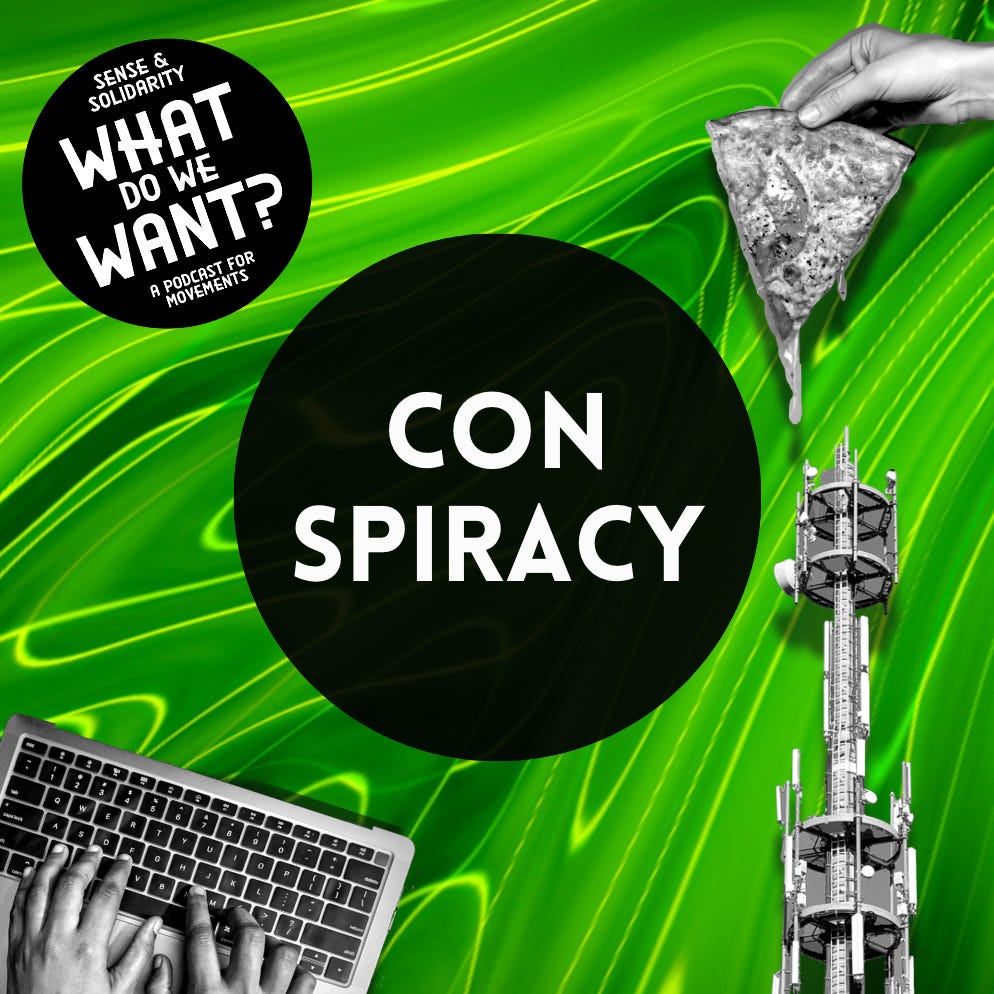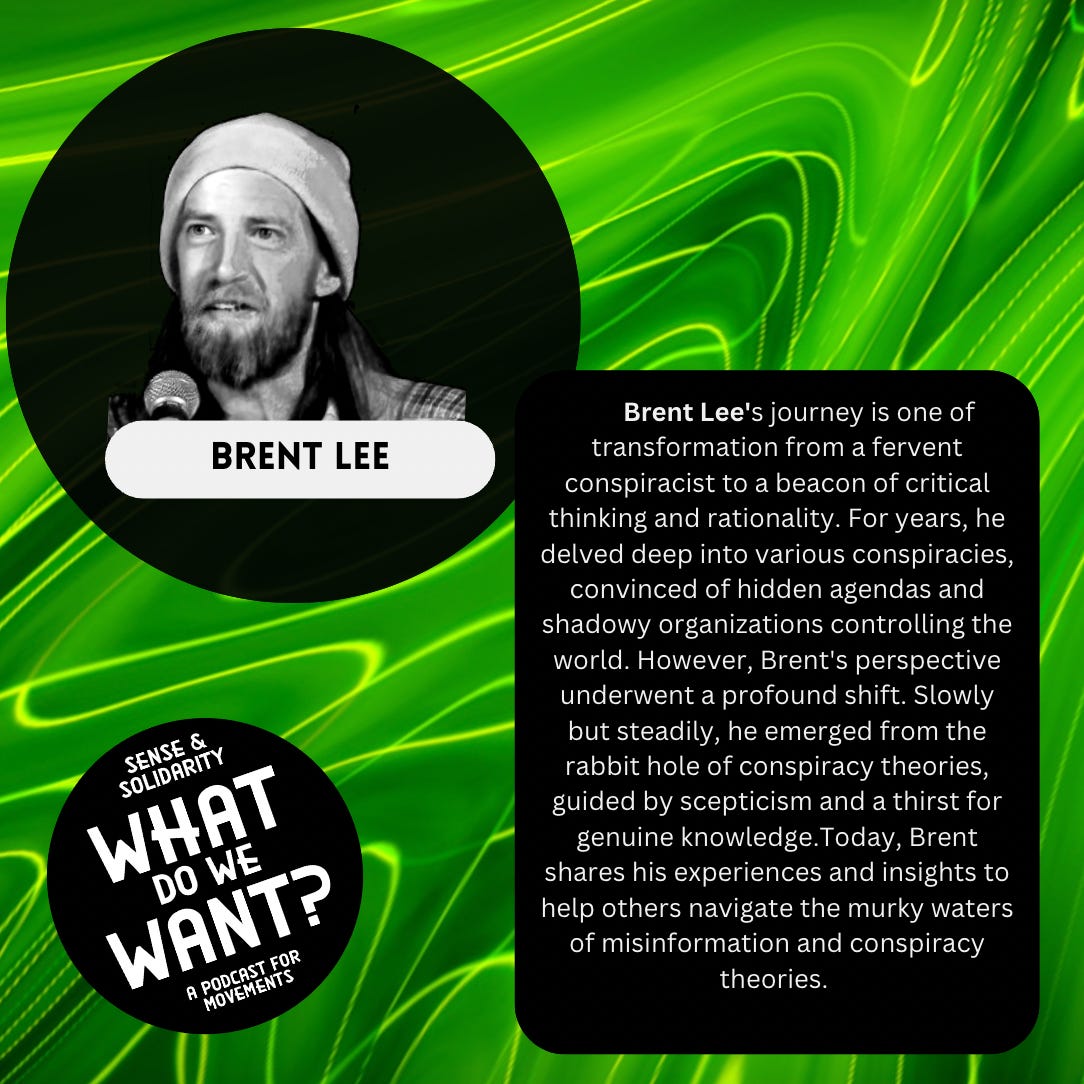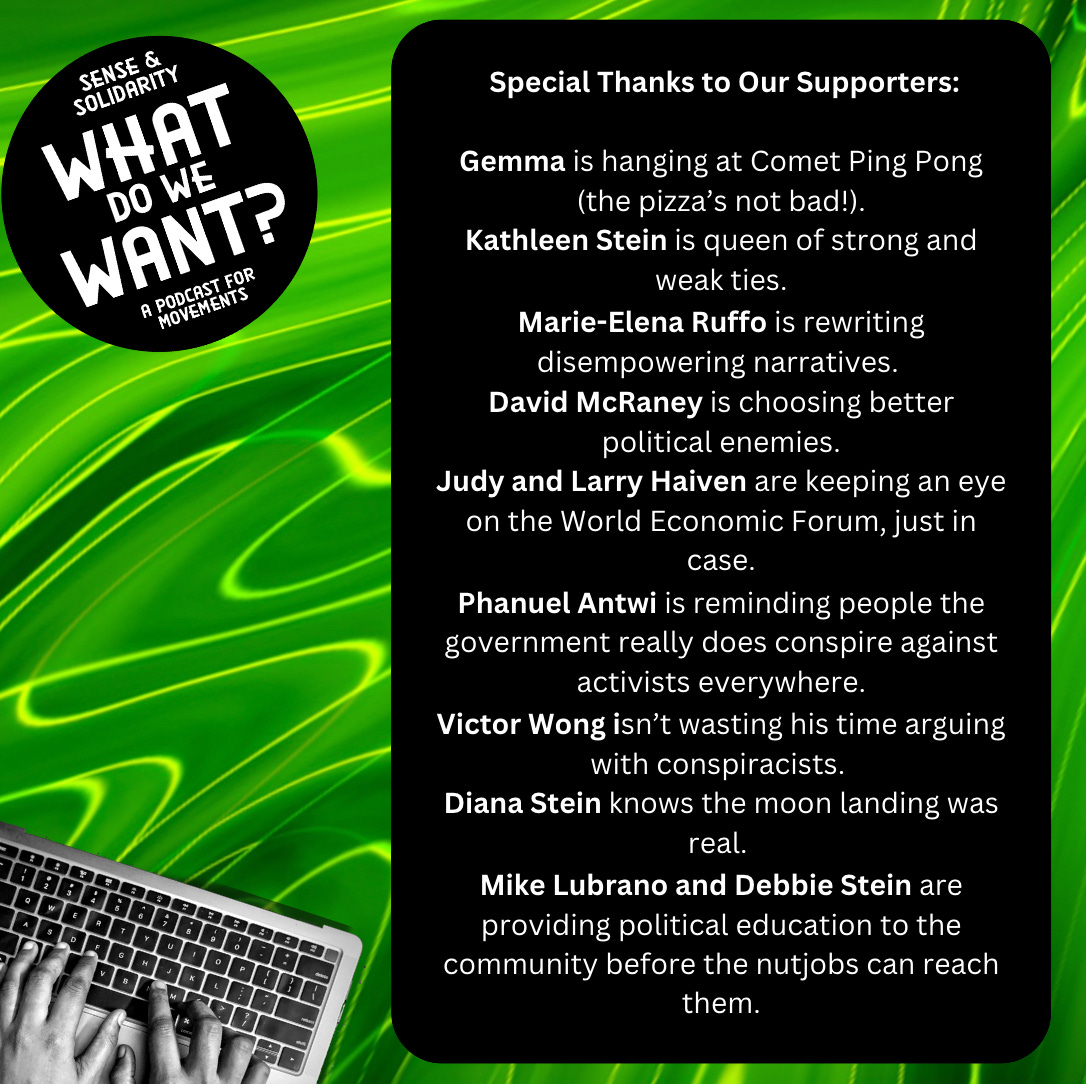Conspiracy theories seem to have taken over the world. And while it can be tempting to blame this on disinformation, the internet, and far-right media and call it a day, there’s a lot more at stake and a lot more for activists to think about.
Like many things that concern social movements, most conspiracy theories are concerned about abuses of power and the schemes of powerful people. So then why do conspiracy theories seem so profoundly successful when most social movements feel like they’re floundering or failing? If your activist work includes talking to strangers, you’ve no doubt encountered many people you’re trying to recruit to your cause who seem in the grips of profoundly delusional fantasies.
What should we do?
We delve into these questions on the second episode of What Do We Want?, a podcast about the wild, weird and wonderful things that bring movements together and drive them apart which draws on Sarah’s expertise on the politics and cognitive science and Max’s expertise on the radical imagination.
Cognitive maps
If we asked you to explain how to walk from one landmark in your city to another, you’d narrate the route to us based on a “map” that appears in your mind. But any such map is necessarily incomplete: there’s a lot of stuff in there we don’t know or have forgotten - the particular kind of store that’s on a well-known corner, or the name of a sidestreet. In fact, one can have lived in a city all one’s life and only really know 2-3% of it. But to make that mental map functional, our brains fill in the rest, and they usually give us a (false) sense of confidence that we know our city comprehensively.
The same thing happens with our view of the political world. The economy and society we’re a part of is more complex than even the biggest metropolis, and our experience of it is tiny (even experts have only a pinhole of a vantage point on the big picture). We rely on frameworks, theories, and ideologies to help simplify and explain this complexity, to map this world.
In fact, like a bird who scavenges garbage to make a nest, we usually cobble together a map of our economic and political world from stuff we pass by: things we hear in the media, stuff our friends and family say, information we (mis)remember from school. To make matters worse, we tend to be attracted to and retain the stuff that agrees with our preconceived ideas, making our maps profoundly uncertain. Like the proverbial millionaire industrialist whose discerning driver chauffeurs him through the city along routes where he’ll never have to see the poverty in which his workers live, we, too, typically create a map of our world that suits us, based on our selective experience and exposure..
A conspiracy theory offers resources for cognitive mapping. It might be thought of as a bit like a secret subway system that links different points in a city: it shows how things that at first may seem unrelated are connected. People are often attracted to conspiracy theories because it is comforting to know that you understand why things are happening (it’s all the lizard people!), even if you can’t do much about it.
Action possibilities and righteous identity
A cognitive map of a city gives a citizen an orientation in the world, including action possibilities: ideas of where they are and where they could “go”. It tells us (often wrongly) what neighborhoods are nice and dangerous. A cognitive map of politics doesn’t just tell us how power works in our world, it also informs us, implicitly, of what we, as people, can do within that system.
Conspiracy theories also offer us action possibilities. Sometimes, they show us that we must band together to oppose the evil cabal of pedophiles. Other times, it shows us that the conspiracy is so vast and so horrible we can’t do anything about it except perhaps “wake” others, and in a weird way this is somewhat comforting.
When those of us who are part of or care about social movements think about conspiracy theories, we ought to ask: “what are believers getting out of the experience?” They are often getting a convincing cognitive map that makes the world make sense (for a change). They are often getting a clearer sense of their action potentials (even if they are convinced there’s nothing they can do except “learn the terrible truth”).
In an online age, conspiracy theories also often provide believers with a community of righteous people who are also outcasts because of their noble mission to learn what’s really going on. They can affirm their identities as people who care about the truth and about victims of conspiracies (even if they don’t really do anything about them).
Rather than curse conspiracy theories, those of us who are part of or care about social movements should ask: what kinds of cognitive mapping resources are we offering people? What action potentials are implicit in the way we’re presenting the world? What kind of community are we offering the people we’re trying to convince and recruit? What kind of positive identity are we providing for people?
Hate the game, not the player
Conspiracy theories tend to succeed because the resources for cognitive mapping they typically offer rely on a charismatic rather than a systemic theory of power.
A charismatic theory of power would tell us that the reason the world is messed up is that a person or small group of very powerful people are making horrible, self-serving, cynical or manipulative decisions, usually to perpetuate or entrench their power and wealth.
By contrast, a systemic theory of power recognizes that even the most powerful people are the products of systems in which they are completely replaceable. People reproduce the system, but the system also produces and reproduces people.
But, at least in our highly individualistic society, most people have a hard time imagining the way a system works. It’s much easier and more intuitive to think about an individual bad or greedy person pulling the strings. This also resonates with the kinds of films and media we consume, where evil villains are often seen plotting vast conspiracies.
Conspiracy theories also tend to present resistance to power in terms of individuals or small groups, rather than mass movements. We’ve been trained by Hollywood film and a lot of adventure literature and games to imagine that the only thing that can change the world is a small group of disbelieved losers who, against all odds, find the weakness in the proverbial Death Star and heroically blow it up with a well-placed torpedo.
We have very few narratives of collective agency and the slow, hard work of radical social change, which takes years and includes a lot of boring meetings. Even in social movements, we often find ourselves waiting for leaders and saviors.
Movements who want to succeed should make educating themselves and the public about the systemic nature of power a priority. But they might also, strategically, select figureheads as their enemy.
In the conspiracy episode of our podcast, Max related the usefulness of Jeff Bezos as an enemy in the fight against the Amazon corporation, even though everyone knows that if he were to act any differently, he’d very quickly be replaced. All this speaks to the need for movements to prioritize internal and external education.
OK, but what about Dave, who used to be a comrade and is now a bonkers conspiracist?
We hear you. Many of us have lost friends, comrades, and family down the proverbial “rabbit hole.”
What can we do? In this episode, we talk to former conspiracist and now counter-conspiracy podcaster Brent Lee (of Some Dare Call it Conspiracy), who has some very good advice.
But he affirms the sad truth: until people are ready to quit, until the contradictions accumulate to the point they can no longer sustain their beliefs, it’s going to be hard to pull anyone out of a conspiracy community.
If this person matters to you, you can keep the door open. You can ask a lot of questions. You can gently and respectfully point out when things don’t make sense. You can note contradictions. But you should give up on the idea that by arguing with them you’ll break the spell.
It’s important to realize, as noted above, that people in the grips of a conspiracy theory get a lot from it. They get a sense of righteous, noble identity. They get a cognitive map that appears to be coherent, and that can be extremely reassuring. They often get a community of seemingly open-minded, supportive and righteous people who care and are sometimes willing to act together against injustice. They get a sense of purpose. What are you offering to replace all that?
The reality is that conspiracy theories are like pathogens that prey on an already weak body politic: they take advantage of people’s (justifiable) sense of confusion, outrage, helplessness and skepticism towards the official narrative. How can people involved in or who care about social movements catch these people “upstream,” before they fall prey to the lure of conspiracism?
We have seen the conspiracists and they are us
It’s all too easy to make conspiracists into the stupid, misguided, vilified “other.” But as Naomi Klein observes in her book Doppelganger, we must recognize that when we see conspiracy movements, we are seeing social movements in a funhouse mirror, an upside down world that is distorted but still recognizable.
It’s also of course important to remember, as Erica Lagalise reminds us, that the modern history of the radical left began in conspiracies (slaves conspiring to revolt; workers joining secret societies and unions; professional revolutionaries swearing oaths of revenge, etc) and also that power does, indeed, work through conspiracies: powerful people do whisper together in back rooms - it is part of systems too.
Rather than making fun of conspiracists, we should be asking: what can we learn from their success? It’s not a matter of emulating their deplorable methods. It’s a matter of asking: what needs are conspiracy theories meeting for people, and how could those needs be met otherwise?









